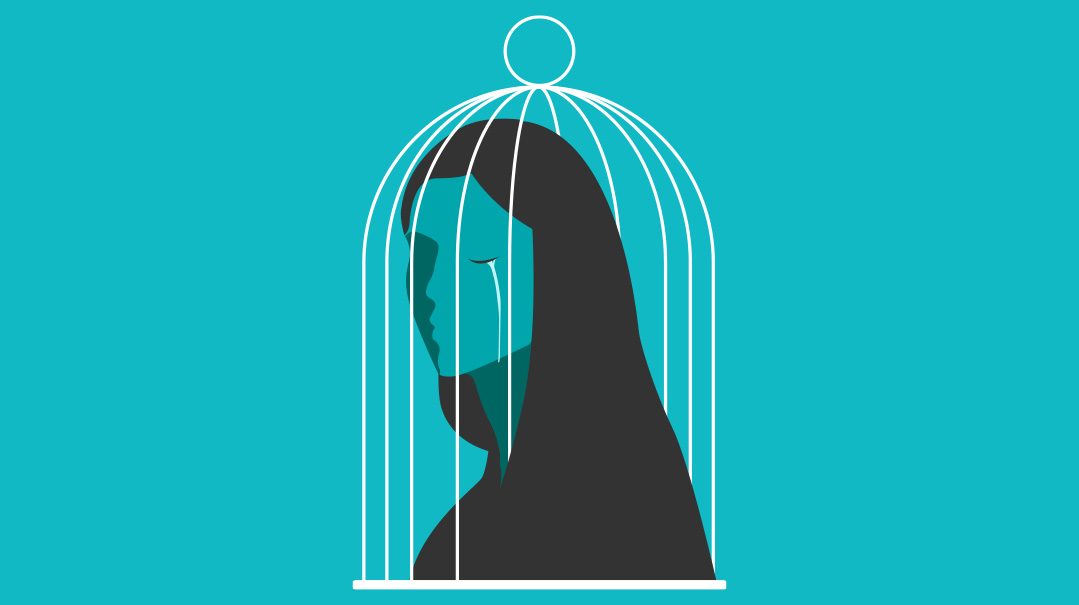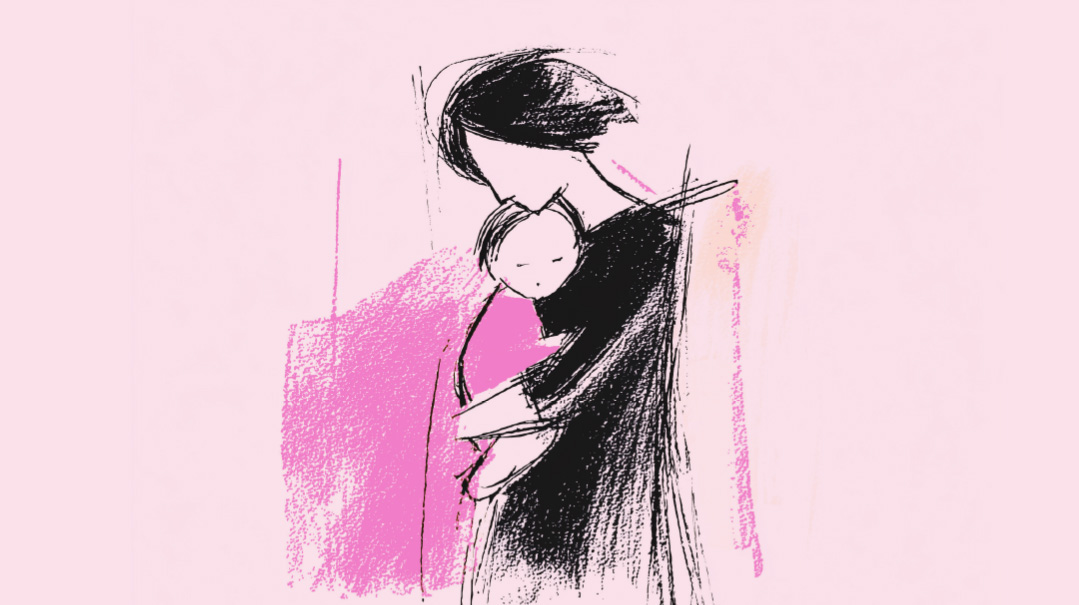Trapped Tears
| March 22, 2022Five common mindset blockages of grief — and how to move beyond them

“IF ONLY…”
When people hear that I’m a Grief Recovery Specialist with Grief UK, they sometimes assume I work exclusively with mourners who are bereft over the death of a loved one. But actually, there are over 40 different kinds of personal losses that can trigger emotions of grief. This includes divorce, retirement, loss of health, relocation, a child going off the derech, infertility, and more.
Regardless of why my clients are grieving, they commonly look back on the past and say, “If only circumstances had been different or better, if only I’d done more.”
One client, Aviva*, endured a long, difficult marriage before her divorce. “I’m a mess,” she told me during our first session. Even though she’d been divorced for several years already, she couldn’t put it behind her.
“I have so many regrets, so much remorse for what I did wrong,” Aviva shared. “If only I could’ve been a better mother to my children while I was going through that terrible time, maybe then my middle child wouldn’t be so resentful of me.”
I suggested to Aviva that alongside these feelings of “I wish I did more,” she was also probably chastising herself for all the “I wish I hadn’t done that” actions and decisions that had backfired on her.
“How did you know?” she asked surprised. I explained to Aviva that when someone is trapped in an “if only” mindset blockage, they focus exclusively on errors, whether it’s for something they did — or didn’t — do.
Another client, Sarah, was similarly consumed by “if only” thoughts after her husband was niftar. Sarah’s husband Dovi had had a painful illness for a number of years, but his death came as a shock to the family because of its sudden nature.
Sarah had called the doctor the morning of Dovi’s death, as she felt that something was slightly off with her husband. But the doctor’s appointments were already taken, and it didn’t appear to be an emergency.
“If only I’d pressed for an appointment,” Sarah lamented. “If only I would’ve taken him to the emergency room. If only I would’ve realized how sick he really was.”
These kinds of thoughts attach people to the past and hinder the healing process. So, what can we do to move beyond the “if only” mindset blockage?
It helps to start by acknowledging, and humbly accepting, human imperfection — especially our own. Since we tend to focus on our mistakes, it’s worthwhile to contemplate the numerous occasions when we didn’t err — all the times we acted wisely or rose to the occasion. This helps to create a more balanced and reflective view of the past.
For example, during the years Sarah served as her husband’s medical support and advocate, she made numerous wise and, at times, life-saving decisions on her husband’s behalf. Similarly, Aviva was a rock for her children, taking on the role of both mother and father during the tumultuous years leading up to and following the divorce.
Another way grievers can avoid the “if only” mindset blockage is through acceptance.
The goal is to accept that you did all you could do — given the circumstances you were in, the particular time and setting of the situation, the personality you were born with, and your individual limitations.
By design, life doesn’t have a reset or rewind button. We cannot go back and change events. And in the present, we don’t have the gift of hindsight. We can only operate with the information we have on hand and with the resources and support system available to us.
Replacing “if only I’d done this, if only I’d done that” with “I can only do what I can do” and “I did the best that I could do,” can help free us from the “if only” mind block.
THE GUILT TRAP
The Sterns had given the world on a silver platter to their only daughter Leah. So when Leah chose to adopt an alternative and estranged lifestyle, and moved away from home, the Sterns grieved deeply. As I was listening to the parents share their painful story, I heard a lot of “if only” feelings, but there was also a much stronger emotion present: guilt.
“We must be terrible parents if this is what happened,” they told me.
What I’ve seen time and again is that when guilt shows up during the grieving process, it’s either misplaced or unwarranted. To help clients see this for themselves, we usually dissect the word “guilt” together to better understand its meaning. And there are many meanings. Looking through six English dictionaries, I came across such differing definitions of guilt:
Dictionary 1: “Intent to harm”
Dictionary 2: “A sense of shame because one knows one has done wrong”
Dictionary 3: “The state of having broken the law”
Dictionary 4: “The blame for having done wrong”
Dictionary 5: “Committed an offense”
Dictionary 6: “Belief one has done wrong”
When these definitions are laid out in front of grievers, they usually realize that the guilt they’re feeling is undeserved — that they’re being too hard on themselves.
With the Sterns, we went through these definitions one by one:
Did the Sterns have any intention to harm their daughter? No.
Should they feel a sense of shame when it’s their daughter who chose to adopt a foreign lifestyle? No.
Have they broken the law in any sort of way? No.
Do they deserve to be blamed because, as parents, they made some mistakes? No.
Have they committed an offense? No.
Should they believe that they did the wrong thing by following daas Torah and qualified professionals? No.
These questions helped the Sterns challenge their sense of over-responsibility. There was no need to wear the yoke of guilt any longer because they weren’t guilty. Instead, they adopted a new mentality of, “We tried to pave a path, but an alternative trajectory emerged. We don’t know what the future will bring. We can do our best today and hope that tomorrow will bring a successful outcome.”
STIFLING GRIEF BY STAYING BUSY
I received a call one day from my good friend Adina, who was asking for guidance. “I don’t know how to react to the way my best friend Chayelle is handling her son’s death,” she said.
Chayelle’s young son had died suddenly and tragically, causing a wave of shock and sadness in her entire community. Adina had been at her best friend’s side when the doctors informed Chayelle of her son’s untimely death. They were together during those first intense moments of shock, loss, and grief.
“After the shloshim for her son, Chayelle threw herself back into normal life,” Adina told me. “But I feel like she did it far too quickly. She leaves for work early, puts in a long day, and then comes home to a house full of kids who need her until late at night. When I asked Chayelle why she’s pushing herself so hard, she admitted to me that keeping busy is the only way she can cope and move beyond her loss.”
This answer didn’t satisfy Adina. She encouraged Chayelle to consider different approaches to grieving, but Chayelle refused.
“I’m worried about my friend,” Adina said. “She’s not giving herself time to grieve, so how can she actually move beyond it? I’m afraid this is going to backfire on her and her family. Can I do anything? Should I do anything?”
Chayelle’s reaction to her son’s death is known as compartmentalization. In the face of intense grief, people sometimes isolate and cordon off painful feelings so that they don’t surface at inappropriate times or places — like during carpool or while in the supermarket. Compartmentalization is often necessary with grief as one cannot always allow emotions to consume them or to interfere with daily functioning. This was likely the case with Chayelle, who had a husband and other children to care for, as well as a full-time job. But it sounded like instead of creating time to face and work through her emotions, Chayelle was denying them existence — she was suppressing them.
Suppression is taking compartmentalization to a new level altogether. And it never works. As much as we may wish to do so, we cannot skip out on grief. When we overpack our schedule to keep busy, it may appear that we’re successfully keeping our pain at bay. But it’s still there, bottled up and potent as ever beneath the surface. Furthermore, it will most probably erupt forth when given the slightest opening to do so.
Not only does keeping busy wear us down, but we’re no further along in our individual healing process; our heart is still broken.
The opposite approach — taking an extended leave of absence from life after a loss — can be unhealthy, too. Emotions and feelings should be worked through, but within a realistic framework of time, given our unique circumstances and obligations. The goal is to find a happy medium where we work through losses from the past by acknowledging them, processing the pain, and then adjusting to a new normal.
I told Adina that the situation she’d described made me think of the quote, “I keep busy with the things I do, but every time I pause, I think of you.” By running on a hamster wheel, Chayelle was attempting to avoid any pauses, which would remind her of her loss.
Now back to Adina: what could she do from the sidelines? I empathized with Adina because it’s hard to watch your friend struggle, especially when you’re aware that she’s making matters more difficult for herself in the long run. But I also reminded Adina that being busy is a choice, a choice that her friend Chayelle seemed to be making. And since Chayelle was adamant that keeping busy was helping her, and she was unwilling to try an alternative approach, there was really nothing Adina could do.
“We cannot choose the choices of another person,” I told Adina. “Just be there for her and don’t give up on her. That’s the greatest support you can give her while she’s stuck in this mindset blockage.”
FIVE STAGES OF GRIEF
After her mother passed away, Simi searched for literature on bereavement, hoping it would help her cope with her loss. She came across the classic book, On Death and Dying, in which author Dr. Elisabeth Kubler-Ross introduces the now-famous theory that there are five stages of grief: denial, anger, bargaining, depression, and acceptance.
Simi attempted to apply these stages to the emotions that she was feeling, but it just wasn’t working for her.
“Am I doing something wrong?” she wondered. “Why isn’t my grief normal?”
Shani described a similar experience. She was expecting to go through all five stages of grief after her mother’s passing, but she skipped right over the first four. She explained to me that her mother, Mrs. Cohen, was 97 when she passed. She’d led a fulfilled and blessed life, and was “sharp as a needle” until her dying day. In the weeks leading up to her death, all of her children had come to visit her, as well as many grandchildren and great-grandchildren. She was enveloped by the support and kindness of those whom she loved and who loved her dearly.
“We’re sad that she’s no longer with us,” Shani told me. “But we’re not at all angry or depressed. We’re not in denial and we never felt a need to bargain. We feel blessed to have had the chance to say goodbye, ask forgiveness, and watch her leave this world to go to her ultimate resting place, the place she has earned.”
Behind the frustration that Simi and Shani felt with the Kubler-Ross model of grief is actually a simple, but common, misunderstanding. They both assumed that the “five stages of grief” were definitive, set in stone. In reality, even Dr. Elisabeth Kubler-Ross herself said it was a theory, not a fact. She states that the five stages of grief are a tool that may help one frame and identify what they’re feeling. But they’re not stations on some linear timeline in grief. Not everyone goes through all of them or in a prescribed order.
Grief is an iterative, repetitive process. It isn’t a linear progressive experience. It doesn’t follow a definitive set of steps, but rather differs from person to person and situation to situation. Rarely will a person sit with denial for a set period of time before she moves on to the next emotion in line. More commonly, grievers find that they alternate between emotions traveling to and from repeated feelings — for example, from sadness to despair and back again. And just when grievers feel that they’ve moved beyond a particular emotion, the emotion may return again, reminding them that they are still processing and working through that particular part of grief and pain.
For Simi and Shani, just hearing that the way they were healing was “normal” and that they were processing their pain in a healthy way — even if it didn’t follow the famous timeline — was enough to free them from this grief mindset blockage.
ENSHRINEMENT AND BEDEVILMENT
When I walked into Julie’s house, I felt like time had reached a standstill.
Even though Julie was in her seventies, her hallway depicted a typical scene of what her parents’ home looked like, years earlier. Her deceased mother’s hat was on a stand on the left side of the living room. Matching symmetrically was her deceased father’s hat on a stand at the right.
This type of behavior is linked to what’s known as “enshrinement,” where grievers fixate exclusively on the positive, fond memories of the person they lost.
In its most damaging form, enshrinement leads people to compulsively build memorials to the person who died. For example, some may refuse to dispose of belongings. In Julie’s case, it was a small list of items. But in some cases, the deceased’s room is kept entirely intact, despite the passing of the person many years prior.
A more common type of enshrinement occurs in the mind, when grievers limit memories of the deceased to ones that glorify them. The problem is that maintaining an exclusively positive memory doesn’t view the totality of any given relationship.
The same argument can be made for “bedevilment,” which is when grievers fixate on the negative, bitter memories of the deceased. This usually occurs when a griever is unable to let go of disappointment and anger.
Both enshrinement and bedevilment fail to encapsulate a truthful relationship dynamic.
The deceased weren’t perfect beyond perfect (nor wicked beyond wicked). Accepting this reality allows grievers the space to truly savor the positive memories, and also heal from the negative parts of the relationship.
I was once talking to a client whose daughter was tragically killed by a drunk driver. She read many of my articles on grief, but there was one line that stood out the most for her, and served as her anchor on the day of her daughter’s yahrtzeit. The line was a quote from Martin Lewis, speaking about his own mother’s passing: “Better to remember the wonderful person you lost than to remember that you lost a wonderful person.”
*All names have been changed to protect privacy.
(Originally featured in Family First, Issue 786)
Oops! We could not locate your form.







